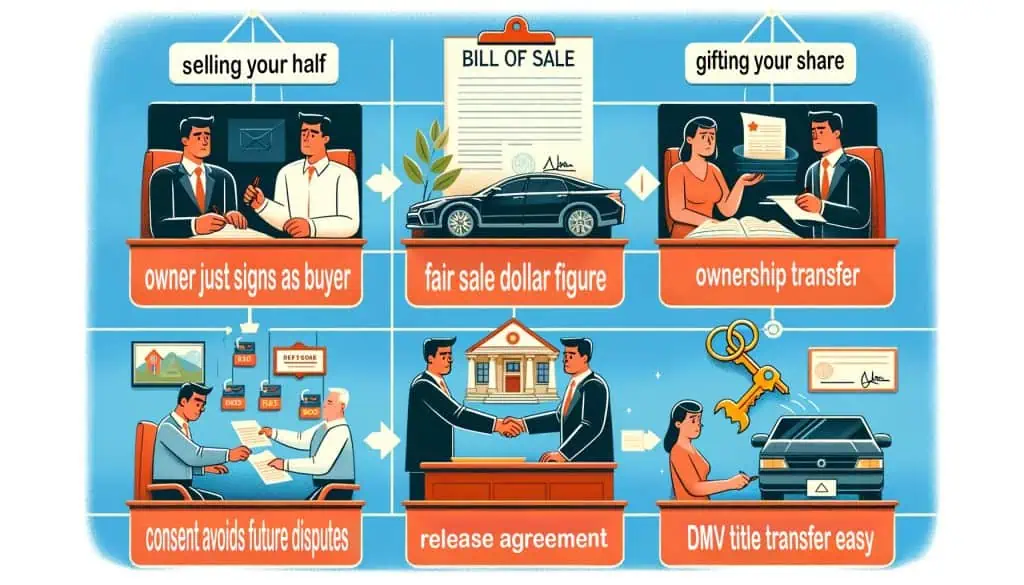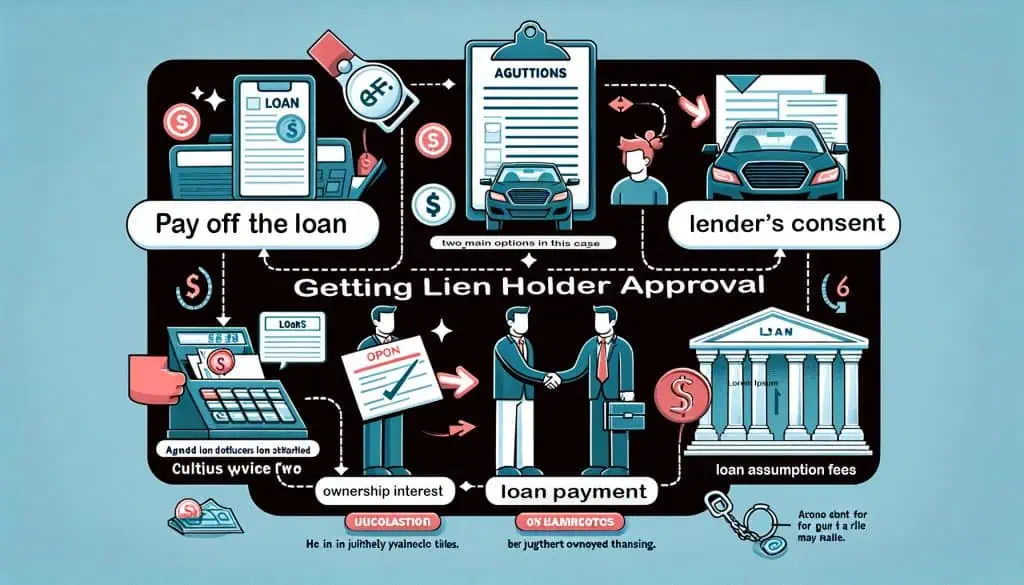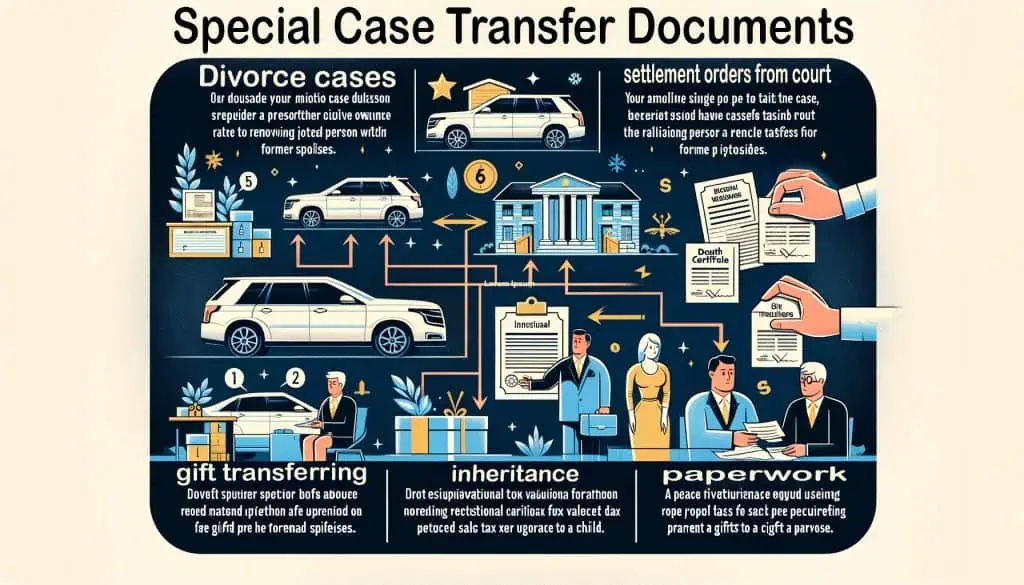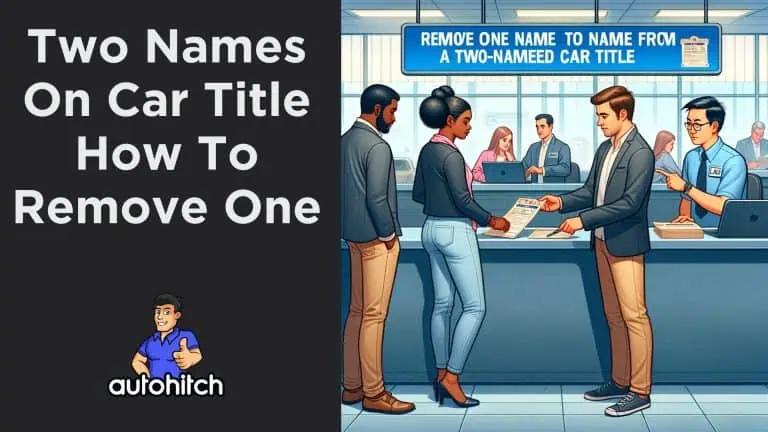Removing a name from a jointly owned car title is a straightforward process similar to selling your vehicle, and as a dealer I often had to do this for people to be able to sell or trade their car in with me.
The key steps are getting consent from the current owners, filling out the title transfer paperwork correctly, submitting forms to the DMV, and resolving any outstanding liens.
How to Remove Co Owner From Car Title
Here is a detailed, easy-to-understand table showing how to remove a co-owner from a car title:
| Step | Description |
|---|---|
| 1. Determine Ownership Type | Find out if the car title lists you and the co-owner as “joint tenants” or “tenants in common”. This impacts the process required. |
| 2. Get Co-Owner’s Consent | If you are joint tenants, you need the co-owner’s consent and signature to remove them from the title. If tenants in common, you may be able to remove them without consent. |
| 3. Obtain Release Documents | Have the co-owner sign a release document like a quitclaim deed or transfer of ownership form relinquishing their interest in the vehicle. |
| 4. Provide Lien Release | If there is a lien on the vehicle, you need to provide a lien release document from the lender showing the loan is paid off. |
| 5. Complete Title Transfer | Fill out a title transfer application and any other required DMV forms to transfer sole ownership to your name. Provide the signed release documents. |
| 6. Pay Transfer Fees | Pay the required vehicle title transfer fees to your state DMV. Fees vary but are usually $10-$50. |
| 7. Receive New Title | After processing, the DMV will issue you a new, updated title showing only your name as the owner. |
| 8. Update Registration | Once you have the new title, update the vehicle registration to match the new ownership information. |
The key things to have ready are the co-owner’s signed release of interest, any lien release paperwork, transfer application forms, and fees required by your state DMV.
*Below are the steps in more detail along with additional helpful tips you can use to simplify the process.
Table of Contents
Relevant Article to Read:
- My Ex Forged My Signature on a Car Title
- How to Transfer A Car Title To A Family Member
- How to Transfer a Car Title After Death of Owner
- How To Sign Over A Car Title
- Should Both Spouses Be on the Car Title?
When Do I Need To Take A Name Off A Shared Car Title?
Common reasons two names end up listed as owners on a title that require removing one include:
- Selling the vehicle to the other owner
- Gifting your share of ownership
- Divorcing your spouse who was the co-owner
- Transferring the car to another family member
You may decide remove yourself, gift your portion to the other owner, or formally sell your share outright. Whatever the reason, the process is essentially the same.
Checking The Title For Owner Names
Before starting, you need to check how the current owners are listed on the front of the title. The conjunction used between names determines if both owners’ consent is necessary.
- If names are joined by “and”: Both listed owners must agree to the change by signing as sellers.
- When joined by “or” or “and/or”: Only one owner’s signature is legally needed to proceed.
Special note: Arizona titles treat “and/or” the same as “and”, so joint consent would be required there.
Relevant Article: How To Sell a Car in AZ
Getting The Other Owner’s Consent

Since our example assumes shared ownership, consent avoids future disputes over the transfer. Have a simple bill of sale and ownership release agreement both owners sign for documentation.
Consider a few consent tips:
- If gifting your share, the other owner just signs as buyer
- For selling your half, agree on a fair sale dollar figure
- In divorce cases, follow court orders for ownership transfer
- For inheritance transfers, the estate executor handles consent
Having consent upfront makes the DMV title transfer easy.
Filling Out The Car Title Transfer Paperwork
Now comes the official part where you put the agreed upon changes down on paper by filling out the title transfer forms correctly.
Here are clear steps ensure you complete this properly:
- The owner being removed signs their name on the “Seller” line on the title’s rear.
- The owner keeping the vehicle signs on the “Buyer” line.
- Odometer and sale price figures must be provided, even for non-sale gifts.
- Double check form completion – mistakes could mean rejection!
Some DMVs require notarization of the signatures or submission in person. Check ahead of time with your local office to ensure proper procedures are followed.
Getting Lien Holder Approval

If an auto loan or lien exists on the title, you simply cannot remove the co-owner without the lien holder’s approval. Why? Because legally the lender also has an ownership interest.
You have two main options in this case:
- Pay off the loan to obtain lien release – you can then submit the title transfer without lender input. Of course this assumes you can afford to pay the outstanding balance.
- Get the lender’s consent for the ownership change while loan payments continue – some may simply agree while others could require loan assumption fees or refinancing into one owner’s name exclusively before approving the alteration.
Consult closely with lenders before attempting any jointly owned title changes. Every lien holder handles these situations differently.
Applying For Your New Title
The last part involves submitting signed transfer paperwork to motor vehicle bureaus to process a fresh title just in the remaining owner’s name. Here are final title transfer steps:
- Visit your local DMV title office in person
- Bring license, registration, insurance proof documents
- Pay relevant title transfer taxes and fees
- Get new single owner title document
Some states permit title transfers by mail if you can’t visit DMV locations conveniently. Check requirements for your particular state.
Below are helpful sections covering special scenarios, typical fees to expect, and frequently asked questions when removing names from dual ownership vehicle titles.
Special Case Transfer Documents

Certain unique situations that lead to removing a person from joint car ownership require extra legal documents before titling transfers occur properly:
- Divorce cases often need a copy of final divorce judgement or settlement orders from court to accompany the title application. This sometimes allows waiver of sales tax on transfers between former spouses.
- If the transfer is due to inheritance after the death of one owner, typically an estate executor needs to handle the paperwork, including submitting a death certificate.
- When gift transferring 50% ownership solely to the other individual, such as removing your name as a parent gifting a vehicle to a child, ensure proper gift valuation for tax purposes.
What Transfer Fees & Taxes Should I Expect?
Typical state vehicle title transfer service fees range from $10 to $35 on average. Certain locations like Arizona and Ohio on the lower fee range, while some states like California reach up to $15.
Unless you qualify for exceptions like divorce or gift cases mentioned before, sales tax also applies on the purchase amount when titles change hands. This generally ranges from 2% to 7% of a car’s sale value depending on your state.
Frequently Asked Questions
Below are answers to some of the most common queries vehicle owners have about removing names from two party titles:
Who signs when a lienholder exists?
The owner being removed signs as seller, staying owner signs as buyer. Lienholder must also consent.
Is a notary required?
Some states do need signatures notarized before accepting title transfer applications.
Can I take my ex off if payments remain?
No, unless the lender approves or loan is refinanced.
What about special motorcycle title rules?
The same process applies for cars, trucks, motorcycles boats, RVs, etc.
How do I transfer an out-of-state title?
The steps remain the same, but paperwork gets a bit more complex working across state lines.
Once complete, who owns the car?
Sole legal ownership now rests with the signing buyer alone.
Closing Thoughts
I hope this clearly answers common questions around removing a name off of jointly owned vehicle titles. Let me know if any other issues come up!




2 Responses
My daughter has broken up with her boyfriend. Her name is on the car as well. She wants to get her name off of the title. Her ex boyfriend got a a DUI . The coos at the police station says she is responsible if anything happens. I assume because he doesn’t have a license to drive. I am not sure. She did ask the police officer why she is responsible if anything bad happens. I don’t know if it’s because she took the car out impound. My question is, if ge isn’t willing to meet get at the DMV to her name off of the title, what is her next steps? She doesn’t want the car or anything to do with him. She doesn’t want to be responsible for choices. Thank you for any advice!
Well, first thing you want to check is if the title is X “and” Y, or, X “or” Y. If it’s “Or”, she doesn’t need his signature.
If it’s “And” and he refuses, the only option is the court system and you must contact and pay an attorney. From this moment on save all communications and attempts to get him to help solve the issue because you will need that if something happens or if you have to go to court.
In the meantime, contact the insurance company as get their advice as well, to limit her liability.
That really is all you can do if he is uncooperative.